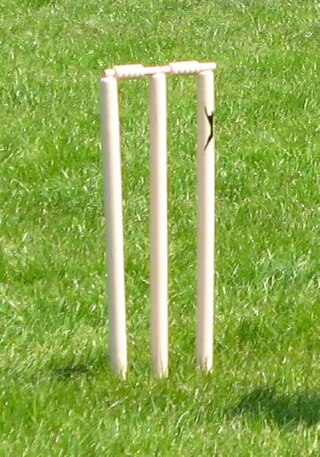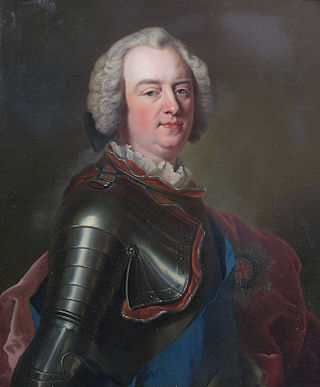Related Research Articles
The Laws of Cricket is a code that specifies the rules of the game of cricket worldwide. The earliest known code was drafted in 1744. Since 1788, the code has been owned and maintained by the private Marylebone Cricket Club (MCC) in Lord's Cricket Ground, London. There are currently 42 Laws, which describe all aspects of how the game is to be played. MCC has re-coded the Laws six times, each with interim revisions that produce more than one edition. The most recent code, the seventh, was released in October 2017; its 3rd edition came into force on 1 October 2022.

In cricket, the term wicket has several meanings:

This is a general glossary of the terminology used in the sport of cricket. Where words in a sentence are also defined elsewhere in this article, they appear in italics. Certain aspects of cricket terminology are explained in more detail in cricket statistics and the naming of fielding positions is explained at fielding (cricket).
In cricket, a team's innings ends in one of the following ways. In cases 1 and 2, the team are said to be all out, because they do not have two players available to bat.
- All but one of the batsmen are out.
- The batting side only has one not-out batsman who is still able to bat.
- The team batting last scores the required number of runs to win.
- The game runs out of time for either side to win, and so finishes as a draw.
- The set number of overs have been bowled.
- The team's captain declares the innings closed.
- The Match Referee decides that one team has forfeited the game.
Cricket is a multi-faceted sport with different formats, depending on the standard of play, the desired level of formality, and the time available. One of the main differences is between matches limited by time in which the teams have two innings apiece, and those limited by number of overs in which they have a single innings each. The former, known as first-class cricket if played at the senior level, has a scheduled duration of three to five days ; the latter, known as limited overs cricket because each team bowls a limit of typically 50 overs, has a planned duration of one day only. A separate form of limited overs is Twenty20, originally designed so that the whole game could be played in a single evening, in which each team has an innings limited to twenty overs.
In the sport of cricket, a declaration occurs when a captain declares their team's innings closed and a forfeiture occurs when a captain chooses to forfeit an innings without batting. Declaration and forfeiture are covered in Law 15 of the Laws of Cricket. This concept applies only to matches in which each team is scheduled to bat in two innings; Law 15 specifically does not apply in any form of limited overs cricket.

In cricket, a scorer is someone appointed to record all runs scored, all wickets taken and, where appropriate, the number of overs bowled. In professional games, in compliance with Law 3 of the Laws of Cricket, two scorers are appointed, most often one provided by each team.
John Small was an English professional cricketer who played during the 18th century and had one of the longest careers on record. Born at Empshott, Hampshire, he is generally regarded as the greatest batsman of the 18th century and acknowledged as having been the first to master the use of the modern straight bat which was introduced in the 1760s. He probably scored the earliest known century in important cricket. The strength of the Hambledon/Hampshire team during Small's prime years can be seen in the team being rated the (unofficial) Champion County in 10 seasons: 1766–1771, 1776–1777, 1779 and 1783. He died at Petersfield, where he was in residence for most of his life and where he established businesses.

The earliest definite reference to the sport of cricket is dated Monday, 17 January 1597. It is a deposition in the records of a legal case at Guildford, Surrey, regarding usage of a parcel of land. John Derrick, a coroner, testified that he had played cricket on the land when he was a boy in about 1550. Derrick's testimony is confirmation that the sport was being played by the middle of the 16th century, but its true origin is unknown. All that can be said with a fair degree of certainty is that its beginning was earlier than 1550, probably somewhere in south-east England within the counties of Kent, Sussex and Surrey. There have been suggestions that it can be traced to Flemish immigrants then resident in the area. The origin of the word cricket could derive from the Flemish word krick(-e), meaning a stick. Unlike other games with batsmen, bowlers and fielders, such as stoolball and rounders, cricket can only be played on relatively short grass, especially as the ball was delivered along the ground until the 1760s. Forest clearings and land where sheep had grazed would have been suitable places to play.
In the years from 1726 to 1750, cricket became an established sport in London and the south-eastern counties of England. In 1726, it was already a thriving sport in the south east and, though limited by the constraints of travel at the time, it was slowly gaining adherents in other parts of England, its growth accelerating with references being found in many counties. Having been essentially a rural pastime for well over a century, cricket became a focus for wealthy patrons and gamblers whose interests funded its growth throughout the 18th century.

William "Silver Billy" Beldham was an English professional cricketer who played for numerous teams between 1782 and 1821. He was born at Wrecclesham, near Farnham in Surrey, and died at Tilford, Surrey. In some sources, his name has been given as "Beldam" or "Beldum". A right-handed batting all-rounder, he is widely recognised as one of the greatest batsmen of cricket's underarm era. Using an underarm action, he bowled pitched deliveries at a fast medium pace. He generally fielded in close catching positions, mostly at slip and sometimes played as wicket-keeper.

The 1744 cricket season in England is remembered for the earliest known codification of the Laws of Cricket. This was drafted by members of several cricket clubs, though the code was not published until 1755. Much of its terminology such as no ball, over, toss, umpire and wicket remain in current use. The season is also notable for the two earliest known surviving match scorecards. The second of those matches, played on Monday, 18 June, was a celebrated event in which a Kent county team challenged an England team at the Artillery Ground, Kent winning by one wicket.

Lionel Charles Hamilton Palairet was an English amateur cricketer who played for Somerset and Oxford University. A graceful right-handed batsman, he was selected to play Test cricket for England twice in 1902. Contemporaries judged Palairet to have one of the most attractive batting styles of the period. His obituary in The Times described him as "the most beautiful batsman of all time". An unwillingness to tour during the English winter limited Palairet's Test appearances; contemporaries believed he deserved more Test caps.
In cricket, a duck is a batsman's dismissal with a score of zero. A batsman being dismissed off their first delivery faced is known as a golden duck.

Matthew Jonathan Walker, known as Matt Walker, is a retired English professional cricketer who is currently the head coach of Kent County Cricket Club. Walker was appointed as head coach in January 2017 having been assistant coach at the county since the 2014 season. He played for Kent for 16 seasons until 2008 and then for three seasons for Essex until he retired in 2011.
William Palmer was an English cricketer who played during the 1760s and 1770s. He was born and died in Coulsdon, Surrey. As a top-order batsman, he was a member of the local Coulsdon Cricket Club and also played county cricket for Surrey. Most of Palmer's career was before cricket's statistical record began in the 1772 season so relatively little is known of him. However, he regularly played in noteworthy matches until 1776. He has been recorded in 24 eleven-a-side matches and in one top-class single wicket match. He was last recorded playing for Coulsdon against Chertsey in 1784 when he was 47 years old.
A variety of Kent county cricket teams played matches from the early 18th century until the formation of the original county club in 1842. The county's links to cricket go back further with Kent and Sussex generally accepted as the birthplace of the sport. It is widely believed that cricket was first played by children living on the Weald in Saxon or Norman times. The world's earliest known organised match was held in Kent c.1611 and the county has always been at the forefront of cricket's development through the growth of village cricket in the 17th century to representative matches in the 18th. A Kent team took part in the earliest known inter-county match, which was played on Dartford Brent in 1709.
In the 1773 English cricket season, there was a downturn in the fortunes of the Hambledon Club as their Hampshire team lost every match they are known to have played, and some of their defeats were heavy. Their poor results owed much to star bowler Thomas Brett having been injured. Three other county teams were active: Kent, Middlesex and Surrey. Teams called England took part in five matches, all against Hampshire, and won all five.

Cricket is a bat-and-ball game that is played between two teams of eleven players on a field at the centre of which is a 22-yard (20-metre) pitch with a wicket at each end, each comprising two bails balanced on three stumps. Two players from the batting team stand in front of either wicket holding bats, with one player from the fielding team bowling the ball towards the striker's wicket from the opposite end of the pitch. The striker's goal is to hit the bowled ball with the bat and then switch places with the nonstriker, with the batting team scoring one run for each exchange. Runs are also scored when the ball reaches or crosses the boundary of the field or when the ball is bowled illegally.

Richmond Green cricket ground, on The Green at Richmond, London, has been a venue for cricket matches since the 17th century. The earliest reference dates from May 1666 and some top-class matches were played there in the first half of the 18th century. A match in 1731, which culminated in a riot, is the earliest in cricket history of which team scores are known. The result of a match in July 1741 is the sport's earliest known tie.
References
- ↑ Buckley, p. 4.
- ↑ Maun, p. 130.
- ↑ Sarah Jewell; J. James Reade; Carl Singleton. "It's Just Not Cricket: The Uncontested Toss and the Gentleman's Game" (PDF). Reading.ac.uk. Archived (PDF) from the original on 28 November 2021. Retrieved 12 March 2022.
- ↑ "Why captains choose not to follow-on these days". Espncricinfo.com. 28 July 2017. Archived from the original on 9 November 2020. Retrieved 9 September 2020.
- 1 2 "Law 13 – Innings". MCC. Archived from the original on 1 October 2017. Retrieved 29 September 2017.